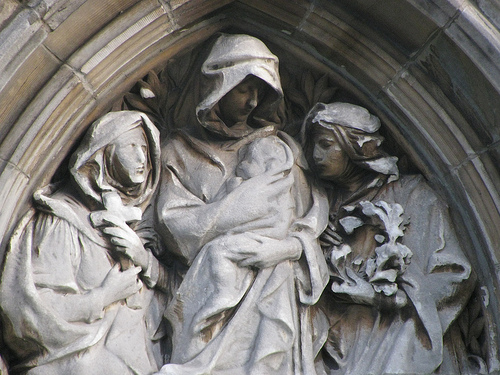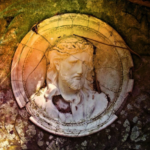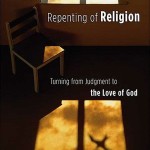We run our website the way we wished the whole internet worked: we provide high quality original content with no ads. We are funded solely by your direct support. Please consider supporting this project.

The Cross in the Manger, Part 2
While some shepherds were tending their flock, an angel appeared to them announcing “good news that will cause great joy for all the people,” for it news about “a Savior…the Messiah, the Lord” (Lk 2:10-11). Most Jews of this time expected a Messiah who would save them by vanquishing their Roman oppressors and liberating Israel to once again be a sovereign nation, as it was under the mighty king David. But, as we know, the way Jesus, the true Messiah, ended up being a “Savior” was not by taking anyone’s life, but by offering up his life. And in doing this, Jesus radically redefined the traditional understand of “Messiah” and “Savior” as well as the “good news” – the “Gospel” – that the Messiah brings.
This is why we must never separate Jesus’ birth, or any other aspect of Jesus’ life, from the self-sacrificial love of God that he most perfectly revealed on Calvary. To the contrary, this self-sacrificial love is the thematic thread that weaves together everything Jesus was about.
No one grasped the thematic centrality of the cross better than Paul. So thoroughly does the cross define the Gospel for Paul that he sometimes uses “the Gospel” and “the message of the cross” as synonyms (1 Cor 1:17-18, 23)! So, to be an enemy of the Gospel of Christ is to simply be an enemy “of the cross” (Phil 3:18). So completely does the crucified Christ define “the Gospel” for Paul that he could tell the Corinthians that he “resolved to know nothing while I was with you except Jesus Christ and him crucified” (1 Cor 2:2). This remarkable statement presupposes that everything we need to know about the Gospel is found in the cross.
This centrality of the cross for Paul is also reflected in his declaration that the cross is the means by which God’s love is most perfectly displayed (Rom 5:8; Eph 5:1-2) as well as the means by which the powers of evil are defeated (1 Cor 2:6-8; Col 2:14-5). It is also the means by which sin is atoned for (Eph 1:7), people are reconciled to God and to each other (Rom 5:10), and people are made righteous, healed, and empowered to live for God (Rom 5:15-19).
Yet, what is, in my opinion, the most astounding confirmation of the central importance of the cross for Paul is found in his teaching that, while unbelievers view it as foolish and weak, to those of us who are “being saved,” the cross it is both “the power” and “wisdom of God” (1 Cor 1:18, 24). In sharp contrast to the controlling power that humans have always lusted after, and thus that they have always ascribed to God or the gods, Paul defines God’s omnipotent power as his willingness to be crucified at the hands of enemies, out of love for enemies! He is saying that, when God puts his omnipotence most perfectly on display, it does not look like Zeus vanquishing foes: It rather looks like God offering up his life out of love for foes.
Which means, if your conception of God’s power doesn’t strike people’s common sense as “weak” and “foolish,” you’ve got a misconception of God’s power, according to Paul.
A cross-centered conception of God’s power understands that it is synonymous with God’s foolish-looking, humble, self-sacrificial love. And it is this same power, and this same love, that we begin to glimpse on that first Christmas morning, when God humbly set his divine prerogatives aside to become a weak, vulnerable baby.
The helpless baby we celebrate on Christmas became the helpless crucified criminal on Calvary, and it’s the self-sacrificial love of God that connects the two and everything in-between.
So as we celebrate the birth of Christ this Christmas, I trust we can discern a beautiful harbinger of the cross in the little child wrapped in swaddling clothes and lying in the manger. I trust we can understand how the foolishness of God becoming that vulnerable little baby is culminated in the foolishness of God becoming that crucified criminal. And I trust we can understand that both reveal the self-sacrificial omnipotent love of the one true God.
Folks, have a blessed Christmas!
Photo Credit: edenpictures via Flickr
Category: General
Tags: Christmas, Cross, Jesus, Power, Upside-Down Kingdom
Topics: Christology
Related Reading

From Good Friday to Easter
This weekend as you contemplate the suffering, death and resurrection of Jesus, we pray that God will reveal his unfathomable love for you in new ways. Blessings to all of you from all of us at ReKnew. Photo credit: Claudio via Visualhunt / CC BY

Overemphasizing Christ?
In response to my work, some have argued that I tend to overemphasize Christ. In light of the claim that in Jesus we have the one and only definitive Word of God and that no previous revelation should ever be placed alongside him or allowed to qualify what he reveals about God, some allege that…

The One True Image of God: God’s Self-Portrait, Part 4
This point is emphasized throughout the New Testament because, if we don’t get this, we are left to our own imaginations about God, and we’ll draw from a multitude of different sources to construct a mental picture of God that will, to one degree or another, fall short of the beauty of the true God…

Did Jesus Instruct Us to Arm Ourselves?
Over the past few posts, I’ve been dealing with the passages that are frequently used to argue how Jesus condoned violence. One of these takes place just after the last supper and just before Jesus and his disciples were going to travel to the Mount of Olives to pray. To prepare his disciples, Jesus tells them;…

The Longing of Advent
The Advent season is a time of anticipating the coming of God, in Christ, a time of turning our imagination toward the revelation of God’s love for us. This after all is the deepest longing of our heart, and our natural longings always point us to something real. We grow hungry only because there’s such…

Quotes to Chew on: God’s Love When We Rebel
“Despite the fall and its consequent curse, however, God’s love was not deterred. God is love. God doesn’t stop being God simply because the humans he created have rebelled against him. God does not abandon his goal of having others share in the eternal, ecstatic dance of the Father, Son and Holy Spirit. The world…
